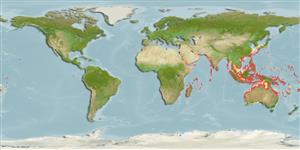Common names from other countries
Environment: milieu / climate zone / depth range / distribution range
экология
; пределы глубины 1 - 50 m (Ref. 4), usually 1 - 8 m (Ref. 4). Tropical; 45°N - 37°S, 30°E - 171°W (Ref. 4)
Indo-West Pacific.
Length at first maturity / Size / Вес / Возраст
Maturity: Lm ?, range 4 - 7.86 cm Max length : 50.0 cm TL самец/пол неопределен; (Ref. 4); common length : 35.0 cm TL самец/пол неопределен; (Ref. 4)
It has a maximum total body length of 50 cm, but usually much smaller (30 to 35 cm) (Ref. 4). It is found in shallow, sometimes slightly turbid coastal waters, from 1 to 8 m depth, with a record of 50 m deep. It inhabits sandy and muddy substrates, sometimes on rocky bottoms, often near the mouth of rivers, but also on coral reefs (Ref. 4). Subtidal (Ref. 106854). Juveniles occur in holes and crevices which are partially covered by seagrass or macroalgae (Ref. 106919). It is solitary, may live in pairs and has been found in larger concentrations (Ref. 4). Omnivore (Ref. 116259).
Members of the order Decapoda are mostly gonochoric. Mating behavior: Precopulatory courtship ritual is common (through olfactory and tactile cues); usually indirect sperm transfer.
Основная ссылка
ссылки | координатор | соавторы
Holthuis, L.B. 1991. (Ref. 4)
Статус Красного Списка МСОП (Ref. 130435)
Статус СИТЕС (Ref. 108899)
Not Evaluated
Not Evaluated
Использование человеком
рыболовство: коммерческий
| FishSource | Sea Around Us
инструменты
дополнительная информация
ресурсы в Интернет
Estimates based on models
Preferred temperature
(Ref.
115969): 24.6 - 29.3, mean 28.4 (based on 3578 cells).
устойчивость к внешним воздействиям
высокий, минимальное время удвоения популяции до 15 месяцев (K=0.57).
Уязвимость
Moderate vulnerability (40 of 100).
